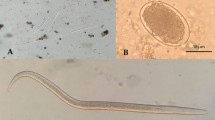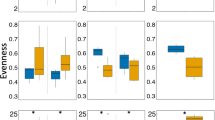Abstract
Though pinworm infestation remains common in laboratory rodent colonies, there is little information regarding current practices for pinworm detection and their relative efficacy. The authors surveyed research institutions to find out the prevalence of pinworm infestations and the detection methods they used. They also tested mice and rats from colonies that were known to be infested with Syphacia sp. and compared the following detection methods: perianal tape test, fecal flotation, fecal concentration, cecal content examination, cecal flotation and histological examination. Though the different methods yielded comparable efficacy overall, the authors recommend using more than one type of test to increase detection potential.
This is a preview of subscription content, access via your institution
Access options
Subscribe to this journal
We are sorry, but there is no personal subscription option available for your country.
Buy this article
- Purchase on Springer Link
- Instant access to full article PDF
Prices may be subject to local taxes which are calculated during checkout


Similar content being viewed by others
References
Pritchett, K.R. in The Mouse in Biomedical Research 2nd edn., vol. 2 (eds. Fox, J.G. et al.) 551–564 (Academic, New York, 2006).
Nakagawa, M. et al. Ten years-long survey on pathogen status of mouse and rat breeding colonies. Jikken Dobutsu 33, 115–120 (1984).
Hasslinger, M.A. & Wiethe, T. [Oxyurid infestation of small laboratory animals and its control with ivermectin; article in German]. Tierarztl Prax. 15, 93–97 (1987).
Baker, D.G. in Flynn's Parasites of Laboratory Animals 2nd edn. (ed. Baker, D.G. ) 303–397 (Blackwell, Ames, IA, 2007).
Bazzano, T., Restel, T.I., Pinto, R.M. & Gomes, D.C. Patterns of infection with the nematodes Syphacia obvelata and Aspiculuris tetraptera in conventionally maintained laboratory mice. Mem. Inst. Oswaldo Cruz 97, 847–853 (2002).
Baker, D.G. Natural Pathogens of Laboratory Animals: Their Effects on Research (American Society for Microbiology, Washington, DC, 2003).
Smith, P.H., Wiles, S.E., Malone, J.B. & Monahan, C.M. in Flynn's Parasites of Laboratory Animals 2nd edn. (ed. Baker, D.G. ) 1–13 (Blackwell, Ames, IA, 2007).
Goncalves, L., Pinto, R.M., Vicente, J.J., Noronha, D. & Gomes, D.C. Helminth parasites of conventionally maintained laboratory mice—II. Inbred strains with an adaptation of the anal swab technique. Mem. Inst. Oswaldo Cruz 93, 121–126 (1998).
Institute of Laboratory Animal Resources, National Research Council. Guide for the Care and Use of Laboratory Animals (National Academy Press, Washington, DC, 1996).
Snedecor, G.W. & Cochran, W.G. Statistical Methods 7th edn. 127 (Iowa State University Press, Ames, IA, 1980).
Acknowledgements
We thank M. Margaret Juliana and Lauretta Gerrity for consultation and manuscript review. Histology services were provided by the Comparative Pathology Laboratory of the University of Alabama at Birmingham.
Author information
Authors and Affiliations
Corresponding author
Ethics declarations
Competing interests
The authors declare no competing financial interests.
Rights and permissions
About this article
Cite this article
Effler, J., Hickman-Davis, J., Erwin, J. et al. Comparison of methods for detection of pinworms in mice and rats. Lab Anim 37, 210–215 (2008). https://doi.org/10.1038/laban0508-210
Received:
Accepted:
Issue Date:
DOI: https://doi.org/10.1038/laban0508-210



